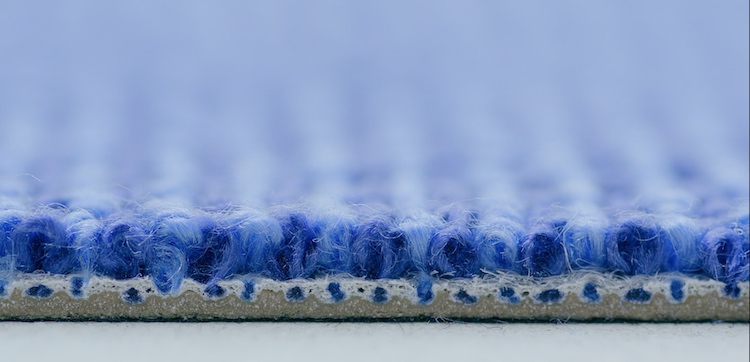The carbon question: What companies can do
January 28, 2018
Jon Khoo, Innovation Partner at Interface, focuses on sustainability, inclusive business and intrapreneurship. Following a former career as a city lawyer, Khoo joined Interface in 2012, having chosen to reapply his skills to tackle the global challenges of marine plastics, inequality and climate change. He led the Interface and the Zoological Society of London’s (ZSL) Net-WorksTM partnership, a community-based supply chain for discarded fishing nets that provides access to finance and seeks to provide long-term conservation benefits.

Published in 2014, the Fifth Assessment Report1 of the UN Intergovernmental Panel on Climate Change (IPCC) concluded that “climate change is real and human activities are the main cause.” From 1880 to 2012, the average global temperature increased by 0.85 degrees Celsius (0.6 degrees Celsius in the last 30 years)2, oceans have warmed, our snow and ice have diminished, and sea levels have risen. In 2016, the New Scientist3reported how the “current rate of loss of Arctic summer sea ice of 13 per cent per decade is equivalent to an annual loss greater than the size of Scotland,” or half of either Bangladesh or Nepal.
The IPCC stated that given current concentrations and ongoing emissions of greenhouse gases, it is likely that the end of this century will see a 1- to 2-degrees Celsius4 increase in global mean temperature above the 1990 level. The Paris Agreement in 2015 represented a landmark agreement to combat climate change as well as to accelerate and intensify the actions and investments needed for a sustainable low-carbon future. The agreement’s central aim was to strengthen the global response to the threat of climate change by keeping the global temperature rise this century well below 2 degrees Celsius5 above pre-industrial levels, and to pursue efforts to limit the temperature increase even further to 1.5 degrees Celsius.
In addition, 195 countries are committed to6:
• Limiting the amount of greenhouse gases emitted by human activity to the same levels that trees, soil and oceans can absorb naturally, beginning at some point between 2050 and 2100
• Reviewing each country’s contribution to cutting emissions every five years so they scale up to the challenge
• Enabling richer countries to help poorer nations by providing ‘climate finance’ to adapt to climate change and switch to renewable energy
Companies have started to realise that climate change represents both a business risk and a business opportunity, seeking to be a catalyst to drive change faster than national governments. Businesses continue to demonstrate a commitment to tackle climate change through their products and processes. In October 2017, a survey of 1,073 businesses by CDP7 (formerly the Carbon Disclosure Project) highlighted how almost 90 per cent have already set some kind of carbon reduction target.
In addition, consumer demand to tackle our environmental and social challenges remains strong—in 2016, 80 per cent of global consumers surveyed agreed businesses should play a role in addressing societal problems, according to the Edelman Trust Barometer.
In the knowledge that the biggest challenge facing the world is climate change, Interface turned its attention to going beyond mitigation, committing to a positive, restorative approach aimed at reversing global warming. The company’s new mission is called Climate Take Back, and the aim is to run its business in a way that facilitates the creation of a
climate fit for life. Interface believes the world must first alter its thinking on climate change and view it as an opportunity, not a problem. Climate Take Back breaks down into four key areas:
• Live Zero: to do business in ways that give back whatever is taken from the Earth.
• Love Carbon: to stop seeing carbon as the enemy, and start using it as a resource.
• Let Nature Cool: to support our biosphere’s ability to regulate the climate.
• Lead Industrial Re-revolution: to transform industry into a force for climate progress

WHY LOVE CARBON
As a manufacturer of carpet tile and modular resilient flooring, the majority of Interface’s environmental impact lies in its products and material supply chain. Tackling its carbon footprint has been a key focal point for how the business tackles climate change. To lead Climate Take Back, the company has reimagined its relationship with carbon. Instead of a problem, the company has sought to better understand it and see it as a resource.
Almost everything on Earth includes a carbon component. For example, plastic, the key component for Interface’s products, are made of hydrocarbons stored within the Earth’s crust as plants photosynthesise atmospheric carbon into carbohydrates. Historically, the planet would self-regulate. Plants would sequester carbon dioxide and that carbon would slowly filter into the Earth or air through various biological processes. However, the Industrial Revolution marked a turning point, with the extraction and utilisation of carbon-based materials, which were turned into waste over time. By not reusing these materials, carbon was emitted into the atmosphere faster than the Earth could absorb it. In short, the world has been putting carbon in the wrong place, rather than using it as a resource.
Instead, what if Interface’s approach could help draw the carbon out of the atmosphere and put it into cycles that restore our environment?
REALISING LOVE CARBON
For the company, stage one of this has been to eliminate its carbon waste. On average, approximately 70 per cent of a material’s carbon footprint is attributed to raw material extraction and processing. To tackle this, the company has focused on embracing high levels of recycled content in its supply chain, such as the use of Aquafil’s ECONYL yarn, made from 100 per cent recycled post-industrial and post-consumer nylon. As a large purchaser of nylon, Interface has been able to put pressure on its supply chain and to share sustainability lessons to enable its suppliers. In addition, it has embraced circular economy approaches, taking responsibility for the take back of its products at end of life (ReEntry) and developing a Cool Blue system that turns old backing into new ones that feature 98 per cent recycled content.
In relation to carbon trading, Interface is now in a position where it could conceivably purchase enough carbon offsets to get to zero and net positive from there. But, the company decided it could take a more restorative stance, to design products to utilise materials that capture carbon and to build on take-back and recycling approaches all aimed at preventing the sequestered carbon from being released into the atmosphere for a generation.
The carbon capturing process and how it works (image courtesy of Interface, Inc.)
LOVE CARBON COMES TO LIFE WITH PROOF POSITIVE
In May 2016, Interface showcased its Proof Positive tile, a prototype carbon-negative product. Created from materials rich in plant-derived carbon, these are converted into a durable, functional material for its yarn and backing. These materials can then be recycled to create new carpet tiles at the end of the product’s life. Keeping this carbon in the
company’s recycling system through its take-back programme ensures that this carbon stays in a closed technical loop where it belongs, rather than in the atmosphere where it would have a negative effect on climate.
Interface’s Proof Positive prototype tile is the first to have a negative carbon footprint, which the company achieved directly through design and manufacturing, without purchasing carbon offsets. Since 1996, Interface has reduced its cradle-to-gate product carbon emissions from an average of 20 kilogrammes of carbon per square metre to just over 7 kilogrammes per square metre in 2016. Though only a prototype at this stage, at less than 2 kilogrammes of carbon per square metre, the concept tile is proof that it is possible to store carbon in products rather than emit more carbon into the atmosphere in the process of making those products.
In its European market, in October 2017, Interface took its first steps to bringing the benefits of the Proof Positive tile to its mainstream products. Available as an option on a selected range of products, its CircuitBac Green backing features the inclusion of bio-based ingredients that provide a carbon-negative alterative to existing materials. It marks the beginning of taking back the elements with the Proof Positive tile.
THE FUTURE IS NOW
It is the company’s intention that this approach to manufacturing products, to utilise carbon as a resource, become mainstream over time, at volume and full scale. It believes that this could become a critical solution to reversing global warming over the long term. Looking beyond its own products, Interface sees the potential for products in the built environment to do likewise, to see the potential of buildings that help create a climate fit for life.
A movement aligned to Interface’s Love Carbon approach is growing across industries and sectors. In the United Kingdom, London’s Heathrow Airport8 has committed to becoming a zero-carbon airport, and we are seeing new materials such as Carbon8 Systems9, a revolutionary process that combines waste CO2 and thermal waste to create a carbon-negative aggregate that is then used to create construction materials for the buildings of tomorrow. Perhaps it is time to change our relationship with carbon; far from the enemy, it could be our building block for a better future.
References
1 https://www.ipcc.ch/report/ar5/
2 https://www.newscientist.com/article/2106119-arctic-summersea-ice-melts-to-second-lowest-level-ever-recorded/
3 https://www.bbc.co.uk/news/science-environment-35073297
4 https://www.bbc.co.uk/news/science-environment-35073297
5 https://www.interface.com/US/en-US/sustainability/carbon-neutral-enterprise.html
Get a copy of the Jan-Feb 2018 edition at our online shop or at newsstands/major bookstores; or subscribe to FuturArc.
To read the complete article, get your hardcopy at our online shop/newsstands/major bookstores; subscribe to FuturArc or download the FuturArc App to read the issues.
Previously Published Commentary
Contact us at https://www.futurarc.com/contact-us for older commentaries.

